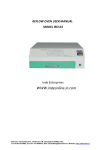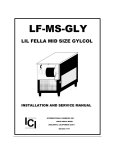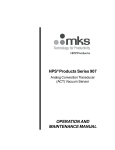Download User Manual - Chart Industries
Transcript
BULK CARBON DIOXIDE SUPPLY SYSTEMS
MVE MODELS CARBO-MAX™ 750 & 450 Mc DONALD’S
Place this manual in the Beverage section of
the Equipment Manual.
MANUFACTURED
FOR
McDONALD’S™
BY
Chart Inc.
407 7th Street N.W.
New Prague, MN 56071-1000
TELEPHONE: 952-758-4484
FAX: 952-758-8275
TABLE OF CONTENTS
WARRANTY
Page 1
SAFETY PRECAUTIONS
Page 3
GENERAL DESCRIPTION
Page 5
OPERATION FACTS AND PROCEDURES
Page 8
McDONALD’S BEVERAGE SYSTEM LAYOUT
Page 9
CARBO-MAX 450 / 750 VESSEL SPECIFICATIONS
Page 10
VESSEL PARTS IDENTIFICATION & FUNCTION
Page 11
FILL BOX PARTS & HOSE IDENTIFICATION
Page 14
TROUBLESHOOTING GUIDE
Page 15
SERVICE AND PARTS
Page 19
SYSTEM FLOW SCHEMATIC
Page 20
© 2010 Chart Inc.
All Rights Reserved
January 2010
Printed in USA
CHART P/N 14347902
Copyright: Chart Inc., January 2010
User Manual
Carbo-MAX™ 750 • Carbo-MAX™ 450
McDONALD’S™
Copyright: Chart Inc., January 2010
Warranty
from Chart’s repair or factory facility, all of which
shall be at Purchaser’s risk and expense.
WARRANTY POLICY
Chart Inc. (“Chart”) warrants to McDonald’s™
Corporation (or its franchisee that issues a
purchase order to Chart) (the “Purchaser”) that
the McDonald’s Carbo-Max™ Bulk CO2 System
equipment (the “Equipment”) shall be free from
any defects in workmanship and materials;
provided, however, that this warranty shall be
limited to Equipment found to be defective
within a period of one (1) year from initial use or
eighteen (18) months from the date of shipment,
whichever expires first, except that parts sold as a
spare or for replacement are warranted for ninety
(90) days from the date of shipment. Chart also
warrants the vacuum in the Equipment for five (5)
years from the date of the original Chart invoice.
Chart warrants that its services will be performed in
a professional and workmanlike manner. All Chart
services are warranted for a period of ninety (90)
days from the date of their completion.
This limited warranty does not apply to Equipment
that Chart determines to have been caused by the
effects of normal wear and tear, erosion, corrosion,
fire, flood, explosion or other excessive external
forces, misuse, abuse, negligence or accident.
Alterations or repairs by any party other than those
designated and approved in writing by Chart, or
installation, storage, maintenance or operation of
such Equipment in a manner inconsistent with Chart
accepted practices, normal operating instructions,
specifications and drawings, or outside the specified
design conditions, unless pre-authorized in writing by
Chart, shall void this limited warranty. Modifications
in any way to the Equipment without Chart’s prior
written approval shall render this warranty void.
This limited warranty does not apply to Equipment
comprised of materials provided or a design stipulated
by Purchaser or to Equipment purchased used.
Negligent handling of the vacuum by the Purchaser
or others, or testing of the vacuum levels by any party
other than a Chart designated and approved party
shall render the vacuum warranty void.
Purchaser agrees that as a pre-condition to
any Chart liability hereunder, Purchaser or its
appointed agents shall fully inspect all Equipment
immediately upon delivery and shall give Chart
written notice of any claim or purported defect
within ten (10) days after discovery of such defect.
Repairs or replacements made pursuant to
warranty shall not renew or extend the applicable
original warranty period; provided however, that
any such repairs or replacement of Equipment
or parts thereof shall be warranted for the time
remaining in the original warranty period or thirty
days, whichever is longer.
As a further pre-condition to any Chart liability
hereunder, an approved Chart service company
must supply both parts replacement and labor and
Purchaser must strictly adhere to the Warranty
Claims Procedure set forth below. Chart’s sole and
exclusive liability under this limited warranty is to
the original Purchaser only and is, at Chart’s sole
option: (1) repair or replacement of the defective
Equipment or parts thereof; or (2) refund the net
purchase price of the defective Equipment or parts
thereof paid by the original Purchaser; or (3) in the
case of nonconforming services, provide equivalent
services or refund the net price paid by the original
Purchaser for such services. Chart shall not be
responsible for providing working access to the
defect, including disassembly and reassembly of
Equipment or for providing transportation to and
Individual parts replacements under warranty and
with a component list price less than $50.00 will be
replaced at no charge. Individual component costs
exceeding $50.00 that are replaced under warranty
will be invoiced to the Purchaser and the Purchaser
will be issued credit based on results of Chart’s
evaluation of the returned component(s). The Return
Material Authorization (RMA) process must be
initiated prior to shipment of any replacement parts.
Chart is not liable for component replacement labor
exceeding 2 hours for actual replacement and 2 hours
travel time (4 hours @ $65.00/hour maximum).
1
Copyright: Chart Inc., January 2010
and Conditions of Sale. In the event of a conflict
between Chart’s Terms and Conditions of Sale
and this Warranty Policy, this Warranty Policy
shall control.
CHART SPECIFICALLY MAKES NO
WARRANTIES OR GUARANTEES,
EXPRESSED OR IMPLIED, INCLUDING THE
WARRANTIES OF MERCHANTABILITY OR
FITNESS FOR A PARTICULAR PURPOSE
OR USE, OR WARRANTIES ARISING FROM
COURSE OF DEALING OR USAGE OF TRADE,
WHICH ARE ALL EXPRESSLY DISCLAIMED,
OTHER THAN LIMITED WARRANTIES
EXPRESSLY SPECIFIED HEREIN.
WARRANTY CLAIMS PROCEDURE
1. All warranty claims must be previously
authorized by: Chart Inc. Telephonic / electronic
approval may be obtained by contacting Chart’s
MVE Beverage Systems Technical / Customer
Services at:
IN NO EVENT SHALL CHART BE
LIABLE FOR ANY SPECIAL, INDIRECT,
INCIDENTAL OR CONSEQUENTIAL
DAMAGES, INCLUDING BUT NOT
LIMITED TO LOSS OF PROFITS, LOST
OPPORTUNITY, LOSS OF USE OF
THE EQUIPMENT, CO2 LOSS, COST
OF CAPITAL, COST OF SUBSTITUTE
EQUIPMENT, DOWNTIME COSTS, COSTS
OF DELAYS NOR FOR ANY PENALTIES,
WHETHER ANY SUCH CLAIM FOR
THE SAME IS BASED ON CONTRACT,
WARRANTY, TORT, NEGLIGENCE, STRICT
LIABILITY OR OTHERWISE. CHART’S
LIABILITY FOR ANY SUCH CLAIMS
WHETHER IN CONTRACT, WARRANTY,
NEGLIGENCE, TORT, STRICT LIABILITY,
OR OTHERWISE OR FOR ANY LOSS OR
DAMAGE ARISING OUT OF, CONNECTED
WITH, OR FROM ANY DESIGN, SALE,
INSTALLATION, OPERATION OR USE OF
THE EQUIPMENT OR PERFORMANCE
OF ANY SERVICES RENDERED BY
CHART, SHALL IN NO EVENT EXCEED
THE PURCHASE PRICE PAID TO CHART
BY PURCHASER FOR THE SPECIFIC
EQUIPMENT OR PART THEREOF OR
FOR THE SERVICES GIVING RISE TO
THE CLAIM. PURCHASER AGREES TO
DEFEND, INDEMNIFY AND HOLD CHART
HARMLESS FROM ANY THIRD PARTY
CLAIMS ARISING OUT OF THE USE, SALE,
OR LEASE OF THE EQUIPMENT.
• Telephone: 800-247-4446
800-253-1769
(Toll free in U.S.)
• Facsimile: 952-758-8275
or by writing to:
Chart Inc.
MVE Beverage Systems
Storage Systems Division
407 Seventh Street N.W.
New Prague, MN 56071-1000
USA
2. Authorization must be obtained from Chart prior
to shipping any Equipment to Chart facilities. In
order to process the return of a vessel its model and
serial number must be provided. If approved, a
Return Material Authorization (RMA) number
will be provided. The RMA number must be
prominently indicated on the packing slip and
any packaging that accompanies the goods being
returned. The customer returning the goods is
responsible for all freight, proper packing, and
any damage incurred during shipment of the
goods back to Chart.
This Warranty Policy is not intended to replace or
supersede the warranties, limitations, exclusive
remedy and disclaimers set forth in Chart’s Terms
Copyright: Chart Inc., January 2010
2
Safety Precautions
CO2 is heavier than air and can collect in low areas
such as basements, stairwells, and confined spaces.
Avoid entry into areas where CO2 leaks or high
concentrations of CO2 are suspected. Enter those areas with
caution only after they have been thoroughly ventilated.
IMPORTANT SAFETY PRECAUTIONS
The type of vessel described in this manual holds
and dispenses carbon dioxide (CO2) gas under
pressure. All persons using this equipment must
read and understand the operation and safety
information contained in this manual and must
be adequately trained to operate this equipment.
Whenever the vessel is inside a building, that
vessel’s safety relief circuit must be connected
to an outdoor vent; typically in the fill box. The
fill box and/or vent must never be located in or
above any below-ground spaces or stairwells. The
vessel must not block emergency exits, aisles,
fire suppression equipment or utility boxes or
accesses. CO2 lines or hoses must be located
away from traffic areas and heat sources and must
be protected from potential causes of damage. All
connections, lines, and components must be leakfree.
CO2 gas is a colorless, odorless, tasteless gas
SUFFOCATION HAZARD.
CARBON DIOXIDE GAS can cause
SERIOUS INJURY OR DEATH.
DO NOT BREATHE CARBON
DIOXIDE GAS.
This equipment should be installed and serviced
only by professional personnel who are qualified
to work with CO2 and the mini-bulk liquid CO2
pressure vessels. They should be familiar with all
pertinent safety procedures.
AVOID ENTERING canister
area if a leak is suspected.
THOROUGHLY VENTILATE area.
FROSTBITE HAZARD.
CONTENTS ARE EXTREMELY
COLD and can cause FROSTBITE.
DO NOT TOUCH liquid, ice, or ice
crystals on or near canister.
STAY AWAY from escaping gas.
that displaces oxygen and does not support life.
The gas is difficult to detect without special
equipment. Avoid breathing or contacting CO2
in gas, liquid or solid form. EXPOSURE TO
CONCENTRATIONS OF LESS THAN 5%
FOR LESS THAN 15 MINUTES CAN CAUSE
PHYSICAL SYMPTOMS INCLUDING
UNCONSCIOUSNESS, INJURIES OR DEATH.
Even low concentrations of CO2 can cause:
• Dizziness, headaches, nausea or disorientation
• Increased respiration or heart rate
• Shortness of breath or rapid suffocation.
3
Copyright: Chart Inc., January 2010
FIRST AID AND EMERGENCY ACTION
If inhaled:
•
•
•
•
Move to fresh air immediately.
If not breathing, give artificial respiration.
If breathing is difficult, give oxygen.
Get immediate medical attention.
In case of frostbite:
• End exposure immediately.
• Do not rub or pour water on the affected area.
• Get immediate medical attention.
Rescue:
• Do not attempt a rescue in areas of high CO2
concentrations without proper life-support or
rescue equipment. (Avoid being the next victim.)
• Thoroughly ventilate areas of possible high
CO2 concentration before entering them.
In case of spills or leaks:
• Evacuate all personnel immediately from
affected areas.
• Thoroughly ventilate the area of the spill or
leak before entering.
• CO2 is heavier than air. It displaces oxygen
and will collect in low or confined areas.
FOR MORE INFORMATION CONTACT:
Local CO2 supplier
or
Compressed Gas Association
725 Jefferson Davis Highway, Suite 1004
Arlington, VA 22202-4100 USA
Telephone: (703) 412-0900
FAX: (703) 412-0900
Copyright: Chart Inc., January 2010
4
General Description
System Overview
The Carbo-Max carbon dioxide (CO2) system
for McDonald’s restaurants is designed for lowpressure storage and supply of carbon dioxide gas
for beverage carbonation and equipment operation.
The supply system consists of three primary
elements: the CO2 storage vessel, an outdoor fill
box, and fill and vent lines.
Vent Circuit
Sure-Fill™ Circuit
Fill Circuit
Contents
Gauge Circuit
Shut-Down
Circuit
Storage Vessel
The Carbo-Max CO2 storage vessel is the main
component of the three primary elements in
the CO2 supply system. It consists of an inner
vessel and an outer vessel constructed much like
a giant Thermos™ bottle. The space between the
two vessels contains a nearly perfect vacuum and
a special insulation. The vacuum and insulation
minimize the entry of unwanted heat into the
liquid CO2 stored in the inner vessel. When CO2
gas is needed, liquid CO2 is withdrawn from the
inner vessel, converted to gas and dispensed to the
beverage system or other use point.
Economizer
Circuit
Gas Supply
(Carbonator &
Syrup)
Vessel Plumbing
Plumbing components on the vessel perform
five functions:
• Liquid CO2 fill (valve)
• Gas supply (gas delivery regulators)
• Pressure maintenance (“Economizer” regulator)
• Safety (Vent/Relief valves)
• Pressure and contents measurement (gauges)
Contents
Measurement
High Phase
Line
The fill circuit allows liquid CO2 to be transferred
into the vessel during the delivery process. The gas
supply circuit dispenses CO2 gas to the beverage
and syrup systems. A pressure control circuit
maintains the internal vessel pressure needed to
supply CO2. The vent/relief circuit allows excess
pressure to safely exit the vessel and the building.
Contents and pressure gauges indicate the status of
the CO2 inside the vessel and the gas supply lines.
6” (15.2 cm) Uni-body legs
5
Vaporizer Coil
Copyright: Chart Inc., January 2010
Fill Circuit
Pressure Control Circuit
The stationary fill circuit consists of a brass fill
fitting in a remote fill station (box), a fill hose,
a valve on the vessel, and a Sure-Fill™ pressure
relief assembly. Liquid CO2 is delivered to the
vessel through the brass fitting in the fill box and
through the transfer hose to the vessel. The shutoff valve on the vessel’s fill port allows service to
be performed on the fill-box / fill-line segment of
the fill circuit without emptying the vessel.
An optional direct fill circuit consists of a brass
fill fitting and bracket secured to the fill port of
the vessel.
The pressure control circuit, also called the
“Economizer” circuit, assists in regulating
the internal operating pressure of the vessel.
Adequate vessel pressure is needed for supplying
CO2 gas and for preventing the stored liquid
carbon dioxide from changing to dry ice, the solid
form of CO2. However, internal pressure that
is too high can cause venting, wasted gas, and
difficulties refilling the vessel. The Economizer
circuit is designed to prevent excess pressure and
the waste of CO2 gas.
The Sure-Fill vent assembly enables fast, troublefree filling without needing to manually vent
excess pressure that develops during a CO2
delivery. The Sure-Fill automatically maintains
the optimum internal pressure during the fill
process by venting excess pressure outdoors
through the safety vent and fill box. It also
automatically stops the fill process when the
vessel is full.
The “Economizing” process is controlled by a
regulator that monitors the vessel’s internal pressure.
When the vessel pressure exceeds the set
point of the regulator (factory set at 140 psi) the
regulator opens allowing CO2 gas to flow directly
into the gas use circuit whenever CO2 gas is
being used. By taking excess gas from the top
of the vessel instead of converting liquid from
the bottom, the internal pressure of the tank is
reduced and controlled.
Gas Use Circuit
Safety Vent Circuit
The gas-use circuit supplies gas to the carbonator,
the syrup systems, and other beverage equipment.
Liquid CO2 stored in the vessel is converted to gas
in the vaporizer portion of this circuit. The CO2 gas
then passes through the shut-down circuit valve into
the respective final line regulator and is dispensed
to the end use point as needed.
The inner pressure vessel of this storage system
is designed to meet or exceed the ASME Section
VIII, Division 1 pressure vessel code. The code
dictates that the vessel be protected against excess
pressure by a safety relief valve. Chart uses two
safety relief valves for added safety. The vessel’s
safety circuit is comprised of an ASME relief
valve set at 300 psig and an additional relief valve
set at 450 psig. The relief valves must always be
vented outdoors by a vent tube, usually through
the fill box, to prevent potential concentration of
CO2 within the building. The 300 psig relief valve
may open during CO2 deliveries or when CO2 is
not being used regularly.
Final line regulators in the gas-use circuit control
gas flow to the beverage and syrup systems.
The factory setting on the carbonator gas supply
regulator is 110 psi but the pressure may be
adjusted to suit the needs of the application.
This regulator is commonly set between 90 psi
and 115 psi for soft drinks. Secondary pressure
regulators may be added ‘downstream’ for
applications such as bag-in-the-box or diet systems.
The syrup gas-use regulator is set at 65 psi for
the syrup system. The use-point equipment
manufacturer should be consulted for the correct
regulator and pressure setting.
Copyright: Chart Inc., January 2010
6
Pressure And Contents Gauges
Fill Hose And Vent Line
The vessel pressure gauge measures the pressure in
the top (gas space) of the inner vessel. The normal
operating pressure range is 140 to 165 psig though
pressures up to 300 psig may be seen for a short
period after a tank-fill.
The third major element of a stationary bulk
CO2 system is comprised of a fill hose and
vent line. These lines join the CO2 storage
vessel with the outdoor fill box. The fill hose,
constructed with FDA compliant materials, is
a pressure rated line that connects the brass
fill fitting in the fill box to the fill valve on the
vessel. The vent line is as important as any
component in the system. It connects the safety
relief valves on the vessel to either the outdoor
fill box or an alternative outdoor vent tube.
The vessel’s contents gauge is a mechanical
device that uses pressure to measure liquid
level inside the tank. The measurement is
accomplished by comparing two pressures;
the “low phase” pressure consisting of the
tank’s gas space pressure and the “high phase”
pressure consisting of tank pressure plus
pressure created by weight of the liquid inside
the tank. The difference between the “high
phase” and “low phase” pressures is translated
by the gauge mechanism to a dial reading
displaying the quantity of liquid CO2 inside the
tank.
NOTE: The vessel must always be connected
to an outdoor vent line when it contains CO2
and is indoors.
The Bulk CO2 Supplier
The bulk CO2 supplier is also an important part of
the system. Most CO2 suppliers not only provide
timely delivery of CO2 but also install and service
the system.
Fill Box
The stainless steel CO2 fill box is the second
major element in a typical bulk CO2 storage
system. The purpose of the fill box is to
provide a convenient point to fill the storage
vessel, to make connections for syrup delivery,
and to vent excess pressure from the vessel out
of the building. The fill box has a brass fill
fitting, a connection for the safety relief vent
circuit, a safety snap connection point, and a
lockable door. Two standard types of fill boxes
are available; a surface-mount model and a
flush-mount model.
For service, parts, information, emergency
CO2 delivery, or other CO2 related assistance,
contact the local Chart authorized CO2
supplier. A place has been designated on page
17 of this manual to record the name and
phone number of the CO2 supplier and other
important service contacts.
Fill boxes must be mounted outside the building
where they are easily accessible to the CO2
supplier and where they can safely vent excess
CO2 pressure outdoors. When a vessel needs to
be moved to accomplish a fill, a vessel-mounted
direct fill fitting and an alternative safety relief
vent line are used instead of the fill box.
7
Copyright: Chart Inc., January 2010
Operation Facts and Procedures
Operation Facts
General Operating Procedures
1. The Mc Donald’s Carbo-Max vessel’s normal
internal operating pressure (43) is between
140 psi and 165 psi.
1. Check for the following unusual symptoms every
day before the start of operations and CO2 use:
•
•
•
•
2. Vessel pressure can be as high as 300 psi after
a delivery but returns to its normal operating
pressure after a day or two of normal CO2 use.
2. Always use caution when working with
CO2. Read and understand the “Safety”
section of this manual.
3. The carbonator gas supply pressure (45) is
normally between 90 psi and 115 psi.
4. The syrup gas supply pressure (44) is
normally 65 psi.
3. The CO2 storage system does not require
adjustment under normal operating conditions.
5. Frost or condensation on the vessel is normal
during periods of CO2 use.
4. Check the vessel daily before using CO2.
See ‘operation fact’ number 10.
6. Frost or condensation on the vessel before the
start of daily CO2 use is a sign of a CO2 leak.
Have the leak fixed.
5. In an emergency the flow of CO2 from or
through the Carbo-Max can be stopped by
closing the following valves:
7. The Carbo-Max 450 holds 453 lb of CO2 for a
use rate of approximately 70 to 100 lb per week.
The Carbo-Max 750 holds 771 lb of CO2 for less
frequent fills or a use rate of over 100 lb per week.
8. The contents gauge (22) displays the amount of
liquid CO2 in the vessel.
9. CO2 becomes dry ice below a pressure of 61 psi.
The shut-off circuit regulator (41) will close and
stop CO2 flow if the vessel pressure (43) reaches
70 psi or less.
•
Valves 33b or 33c to stop the flow of gas to
the beverage or syrup system respectively;
33a and 33d to stop gas flow from the vessel.
•
Valve 30 to stop CO2 flow or leakage
through the fill hose and/or the brass fill
fitting in the outdoor fill box.
•
Valve 33a to stop CO2 flow through the
“Economizer” circuit.
6. For CO2 equipment issues, call your CO2
supplier or service specialist. Before calling
for service or trouble shooting assistance,
please have the following information at hand:
10. An isolation (shut-off) valve is open when its handle
is parallel to the valve body and the line. The valve
is closed when its handle is perpendicular to
the valve body and the line. During normal
use, all isolation valves on the Carbo-Max
vessel should be in the open position.
•
Serial number of the vessel
•
Description of the problem
•
Readings from:
the vessel contents gauge (22),
the vessel pressure gauge (43) and
the final line pressure gauges (46 & 48).
•
Observations such as unusual frosting and/
or events related to the problem.
11. See the trouble-shooting section for additional
information on potential vessel problems.
Copyright: Chart Inc., January 2010
CO2 leaks (See “Safety”)
Pressure readings (43) & (46) & (48)
CO2 contents (22)
Abnormal frost or condensation
8
McDonald’s Beverage System Layout
Syrup Delivery (65 psi)
CO2 Delivery
A
CO2 Fill Box
Syrup Delivery Hose
F
Clean-In-Place
(CIP) Sanitize
System
B
D
H
E
Beverage Machine
(Carbonator)
C
Bulk Syrup
Vessel
(80 Gallon)
Bulk Syrup
Vessel
(80 Gallon)
(65 psi)
(65 psi)
Carbo-Max
Liquid CO2
Storage Vessel
CO2
G
Emergency Back-Up CO2 Cylinder
Item
Description
Function
A
CO2 delivery truck fill line
Periodic transfer of liquid CO2 to on-site storage vessel
B
In-Store CO2 fill line
Transfer of CO2 from outside fill-box to storage vessel
C
CO2 gas-use line to beverage machine carbonator
CO2 gas supply at 90 -110 psi for beverage carbonation
D
CO2 gas-use line to bulk syrup and CIP
CO2 gas supply at 65 psi to push syrup to beverage machine
E
CO2 gas-use line to fill box 2-pin connection
CO2 gas supply at 65 psi to pressurize bulk syrup delivery
F
Syrup delivery line
Bulk syrup delivery line routed through fill box conduit
G
Syrup supply tubing
Transfers syrup from bulk storage vessel to beverage machine
H
Water supply line
Supplies water to beverage machine and sanitation (CIP) system
44
Syrup Side Gas Use Regulator (65 psi)
Controls CO2 pressure to bulk syrup
45
Beverage Side Gas Use Regulator (90-125 psi)
Controls CO2 gas pressure to carbonator
9
Copyright: Chart Inc., January 2010
Carbo-Max 750 / 450 Vessel Specifications
Carbo-Max 750
(P/N 14275161)
Carbo-Max 450
(P/N 14275179)
Dimensions
Diameter
26 in (66 cm)
20 in (50.8 cm)
Height
73.5 in (187 cm)
71.8 in (182.0 cm)
Empty Weight
430 lb (195 kg)
273 lb (124 kg)
Full Weight
1201 lb (545 kg)
726 lb (329 kg)
Net Volume
82 gal (310 liters)
48 gal (182 liters)
CO2 Storage Capacity
(saturated @125 psig [8.6 bar g] )
771 lb (350 kg)
453 lb (205 kg)
Gas Use Connection
1/4” & 3/8” Hose Barb
1/4” & 3/8” Hose Barb
Fill Line Connection
5/8” Male 450 Flare
5/8” Male 450 Flare
Vent Line Connection
1/2” OD Tubing
1/2” OD Tubing
Rates and Pressures
CO2 Delivery Rate
Continuous*
Peak CO2 Delivery Rate For One Hour*
Evaporation Rate**
25 lb/hr (11.3 kg/hr)
(approximately 1400 - 16 oz drinks / hr)
15 lb/hr (6.8 kg/hr)
(approximately 850 - 16 oz drinks / hr
15 lb/hr (6.8 kg/hr)
(approximately 850 - 16 oz drinks / hr)
15 lb/hr (6.8 kg/hr)
(approximately 850 - 16 oz drinks / hr)
3.0 lb/day (1.4 kg/day)
2.5 lb/day (1.1 kg/day)
Max. Allowable Working Pressure (MAWP)
300 psig (20.7 bar g)
300 psig (20.7 bar g)
ASME Relief Setting
300 psig (20.7 bar g)
300 psig (20.7 bar g)
Additional. Relief Setting
450 psig (31.0 bar g)
450 psig (31.0 bar g)
Carbo-Max 750 & 450
Design Criteria
Design Specifications
ASME Section VIII, Division 1
Design Specifications
Meets with US and Canadian approvals
Fill System
Single Line, pressure differential
Internal Vaporizer Coil
Eight wraps for sustained high flow rate
Insulation Type
Vacuum with Super Insulation
Pressure Control
Economizer Circuit
Liquid Level Gauge
Differential Pressure Conversion
Outer Vessel Material
Stainless Steel
Inner Vessel Material
Stainless Steel
Floor mount Design (Meets NSF standards)
Six-Inch Permanent Legs
* Based on 11.25 lb of CO2 / 1000 16 oz. drinks
** No loss in normal applications
Copyright: Chart Inc., January 2010
10
Vessel Parts Identification
McDONALD’S
Carbo-Max 750 P/N 14275161
Carbo-Max 450 P/N 14275179
84
21
80
81
65
64
55
22
26
33e
23
E
52
53
63
F
61
25
33g
24
62
54
20
66
39
31
43
94
51
33f
32
55
33d
68
44
35
54
48
35
47
69
33a
41
33c
57
45
67
73
30
47
50
69
33b
74
42
70
75
49
49a
35
76
46
71
49b
72
95
11
Copyright: Chart Inc., January 2010
Vessel Parts
ITEM PART NO.
20
66
21
22
23
24
25
26
30
31
32
33a
33b
33c
33d
33e
33f
33g
35
39
41
42
43
44
45
46
47
48
49
49a
49b
50
51
52
53
54
55
57
14275363
13832957
14339161
14346985
14339136
1210402
1310152
14285481
11082128
11708451
11708400
13282844
13282844
13282844
13282844
13282844
13282844
13282844
1210462
13154842
13412514
13154851
13412514
13450730
13321014
13041186
13412493
14037779
13412493
13321006
1310092
2015169
14384199
14429668
2914071
13834750
13458820
1210482
13799843
13833731
13832906
1110112
DESCRIPTION
QTY
FUNCTION
Plug, Boss DP Low (w/o-ring) (3/4" - 16) (1/4" FPT)
O-Ring Only, (.924 ID x 1.130 OD)
Flex Hose, SS (1/4" MPT x 12" LG)
Diff. Pressure Gauge, Liquid Level / Contents
Elbow, Brass, 90D (1/8" MPT x 1/8" MPT)
Elbow, Brass, 90D (1/4" FPT)
Nipple, Brass (1/4" x 2 1/2")
Elbow, Street, Reducer, Brass, 90D
Ball Valve (3/8" FPT)
Relief Valve, 450 psig (1/2" MPT)
Relief Valve, 300 psig (1/2" MPT)
Ball Valve (1/4" MPT x 1/4" FPT)
Ball Valve (1/4" MPT x 1/4" FPT)
Ball Valve (1/4" MPT x 1/4" FPT)
Ball Valve (1/4" MPT x 1/4" FPT)
Ball Valve (1/4" MPT x 1/4" FPT)
Ball Valve (1/4" MPT x 1/4" FPT)
Ball Valve (1/4" MPT x 1/4" FPT)
Street Elbow, Brass 90D (1/4" MPT)
Regulator, Economizer, 150 psi (1/4" NPT)
Rebuild Kit For Economizer Regulator (#39)
Regulator, Shut-Off. 70 psi, 1/4" NPT
Rebuild Kit For Shut-Off Regulator (#41)
Tee, Brass (1/4" FPT)
Pressure Gauge, 0-400 psi (1/4" MPT CBM)
Regulator, Syrup Side Gas Use, 65 psi (1/4" NPT)
Rebuild Kit For Gas-Use Regulator (#44)
Regulator, Final Line, 110 psi (1/4" NPT)
Rebuild Kit For Final Line Regulator (#45)
Pressure Gauge, 2" Dial, 0-160 psi (1/4" MPT CBM)
Nipple, Hex, Brass, 1/4" NPT
Pressure Gauge, 2" Dial, 0-100 psi (1/4" CBM)
Support Bracket (Kit) Complete w/U-bolts
U-Bolt, SS (1/4" - 20) (1 1/4" x 3/4")
Lock Nut, SS (1/4" - 20)
Elbow, SS, 90D (5/16" ODT x 1/4" MPT)
Tee, Brass (1/2" FPT)
Elbow (90D 3/8" MPT)
Tube, Relief Valve / Vent
Adapter, Pipe-Away (3/8" FPT)
Tee, Brass Run (1/2” ODT x 3/8" MPT)
Connector (5/8" ODT x 3/8" MPT 45o Flare)
1
1
1
1
1
1
1
1
1
1
1
1
1
1
1
1
1
1
4
1
“Low phase” isolation valve connection point.
Seals low phase DP gauge boss plug #20
“Low phase” line for contents gauge
Indicates liquid CO2 contents
Joins “low phase” line to contents gauge
Joins “high phase” line to isolation valve
Component of high phase DP gauge line.
Attaches high phase line to DP gauge.
Isolates CO2 fill hose from vessel.
Secondary inner vessel safety relief valve
Primary inner vessel safety relief valve
Isolates gas-use side of Economizer regulator
On / off control for carbonator gas supply
On / off control for syrup gas supply
Isolates gas-side of Econ. reg. and main gas -use
On / off control for Sure-Fill vent
Contents gauge isolation valve / high phase
Contents gauge isolation valve / low phase
Connects regulator and valve components
Controls vessel pressure
1
Stops gas flow if line pressure drops to 70 psi
1
1
1
Connects Economizer and gas supply line
Displays internal vessel pressure
Controls CO2 pressure to bulk syrup
1
Controls CO2 gas pressure to carbonator
1
3
1
1
2
4
1
1
1
1
2
2
1
Indicates CO2 gas pressure to use point
Joins components of gas-use plumbing.
Indicates pressure to syrup side use point
Supports gas-use circuit components
Component of support bracket kit
Component of support bracket kit
Joins Economizer and gas-use lines
Manifolds primary & secondary relief valves
Joins 450 psig relief valve to vent circuit
Joins vent circuit components
Joins 450 & 350 psig relief valves to vent fittings
Joins 450 & 350 psi relief valves to vent circuit
Connects CO2 fill hose to vessel
Copyright: Chart Inc., January 2010
12
Vessel Parts
ITEM PART NO.
61
62
63
63
64
65
66
80
81
84
94
95
DESCRIPTION
QTY
13669731 Tubing, Stainless (5/16" OD)
13833757 Connector, SS (5/16" x 1/4" MPT)
“450” Sure-Fill™ Tube Assembly (3/4"-16) (9.25")
13081524 Includes
O-Ring
“750”
Sure-Fill™
Tube Assembly (3/4"-16) (11")
11764313
Includes O-Ring
1213092 Tee, Brass (1/4" FPT x 1/4" FPT x 1/4" MPT)
13154834 Sure-Fill™ Regulator (1/4" FPT) 200 psi
13412514 Rebuild Kit For Sure-Fill Regulator (#65)
(.924 ID x 1.130 OD)
13832957 O-Ring,
[Included with Sure-Fill tube assembly]
13832914 Connector, Brass, 1/2 " ODT x 1/4 " MPT
14275419 Tube, Sure-Fill Vent
1211102
Plug, Brass Hex Hd, 1/4" MPT
13118471 Cap, Black
3911016
Cap, Blue
1
1
Economizer plumbing line
Connects SS tubing to Economizer regulator
1
Controls CO2 filling and pressure venting
1
Controls CO2 filling and pressure venting
1
1
Joins Sure-Fill assembly to S.F. regulator
Vents excess pressure during CO2 filling
1
Seals Sure-Fill tube assembly #63
1
1
1
1
1
Joins Sure-Fill regulator to vent line
Sure-Fill vent line to vent circuit
Plugs access port in tee
Covers vacuum pump-out port
Covers vacuum regeneration port
9722439
INSTALLATION KIT, MCDONALD’S CO2
67
1812352
Relief Valve, 130 psi (1/4") (No Lever))
1
68
1812342
Relief Valve, 75 psi (1/4") (No Lever)
1
69
1213092
Tee, Brass (1/4" F x 1/4" F x 1/4" MPT)
2
70
1111502
Union, brass (1/4" MPT x 1/4" Flare)
1
71
1611821
Elbow, SS (1/4" FL x 3/8" Hose)
1
72
3411331
Clamp, Stepless Ear For 3/8" ID Tubing
5
73
1111512
Tee, Run, Brass (1/4" MPT)
1
74
1111292
Cap Nut (1/4" ODT 45D Flare)
1
75
1611461
Elbow, SS (1/4" FL x 1/4” Hose)
1
76
3411511
Clamp, Stepless Ear For 1/4" ID Tubing
6
-
6511706
Quick Connect, Two Slot (1/4" Tube) (not pictured) 1
-
2811606
Tubing, 1/4" ID Red Line, 20 ft. (not pictured)
-
3411321
Clamp, Stepless Ear For 1/4" ID (not pictured) 4
-
2811586
Tubing, 3/8" ID Red Line, 100 ft. (not pictured) 1
-
2811616
14505691
10807553
11784496
11197611
11197646
Tubing, 1/4" ID Green Line, 5 ft. (not pictured)
Kit, Label, Carbo-Max / McDonald’s
Label, UN2187, Warning Liquid CO2
Label Only, Caution Carbon Dioxide
Label Kit, NYCFD Approval, (Stationary Installation)
Label Kit, NYCFD Approval, (Portable Installation)
13
FUNCTION
INCLUDES PARTS FOR CO2 INSTALLATION
1
1
1
1
1
1
1
Prevents beverage system over-pressurization
(Included in installation kit P/N 9722439)
Prevents bulk syrup vessel over-pressurization
(Included in installation kit P/N 9722439)
Connects gas use line to vessel
(Included in installation kit P/N 9722439)
Connects carbonator gas-use line components
(Included in installation kit P/N 9722439)
Connects with carbonator gas-use line
(Included in installation kit P/N 9722439)
(Included in installation kit P/N 9722439)
Connection port for syrup delivery gas
(Included in installation kit P/N 9722439)
Protects flare fitting (Item 73)
(Included in installation kit P/N 9722439)
Connects with syrup gas-use line
(Included in installation kit P/N 9722439)
Syrup gas-use connections
(Included in installation kit P/N 9722439)
CO2 line connector to bulk syrup vessel
(Included in installation kit P/N 9722439)
Syrup gas-use line
(Included in installation kit P/N 9722439)
(Included in installation kit P/N 9722439)
Carbonator gas line
(Included in installation kit P/N 9722439)
(Included in installation kit P/N 9722439)
15-label set
Included in kit P/N 14505691
(MAWP 300 psi)
Approval #4912 for New York City Installations
Approval #4912 for New York City Installations
Copyright: Chart Inc., January 2010
Fill Box Parts & Hose Identification
Surface Mount Fill Box (P/N 9722329)
Flush Mount Fill Box Shell (Without Panel) (P/N 8512629)
Flush Mount Fill Panel (With Fttings) (P/N 9722859)
5
4
12
77
13
2
64
1
65
11
76
13
2
6
7
64
12
65
80
76
10
77
10
7
ITEM PART NO.
6
1
9
2
DESCRIPTION
QTY.
1
2
4
5
6
7
9
10
11
12
13
64
65
76
77
80
81
11381021
13078181
13104087
12943786
8517839
6511631
4710619
10526989
12943866
2914071
2913981
10973324
10802947
2811726
2811606
2811616
3411511
3411321
8503796
10772160
CO2 Fill Fitting, Brass (includes retainer ring) 1
Lock Assembly (includes key)
1
Key for Lock Assembly (not pictured)
Surface-Mount CO2 Fill Box (without fittings) 1
Flush-Mount Fill Box Panel (without fittings) 1
Quick Connect, 2-Pin
1
O-Ring on boss adapter (not shown)
1
Outside O-Ring ( 5/16” x 1/2”)
1
Fill / Vent Connection Plate / W/O 2-Pin Qk. Conn.
1
Locknut, SS (10 x 32) with nylon insert
Screws, SS (#8 x 1/2”)
6
CO2 Fill and Vent Hose Kit (15 ft. each line)
1
CO2 Fill Hose Only, 15 ft. (2000 psi & FDA)
1
Vent Hose Only, 15 ft
1
Tubing, red line (1/4” ID)
20 ft
Tubing, green line (1/4” ID)
5 ft
Clamp, Stepless (for 1/4” ID green line tube)
6
Clamp, Stepless (for 1/4” ID red line tube)
4
Conduit, Syrup Pass-Thru
1
Pipe Cap 2-1/2” PVC
1
-
11784496 Label, Caution Carbon Dioxide
1
-
10789851 Decal, McDonald’s Fill Box
1
Copyright: Chart Inc., January 2010
14
81
FUNCTION
Connection for CO2 delivery vessel hose
Locks fill box door
Replacement key for fill box
Allows outdoor filling and venting of vessel
Holds brass fill fitting and 2-pin connector
CO2 connection for syrup delivery
Seals 2-pin connection to boss adapter
Seals 2-pin connection for syrup delivery gas
Removable plate for service to tubing connections
Secures fill fitting retainer and connection plate
Secures fill panel to fill box
(Included in installation kit P/N 9722439)
Transfers liquid CO2 from fill box into vessel
Vents excess vessel pressure outdoors
(Included in installation kit P/N 9722439)
(Included in installation kit P/N 9722439)
(Included in installation kit P/N 9722439)
(Included in installation kit P/N 9722439)
(Included in installation kit P/N 9722439)
Syrup pass-thru cover (Included with P/N 8512629)
Troubleshooting
CO2 Storage Vessel
INDICATION
No CO2 to carbonator or
syrup systems.
POSSIBLE CAUSE
CORRECTIVE ACTION
1. Switch to emergency CO2 gas cylinder.
CO2 storage vessel is empty.
2. Call CO2 supplier for delivery.
OR
Carbonated drinks are flat.
Constant low
vessel pressure.
(gauge 43 below 140 psi)
Isolation valves (33a, b, c, d) closed.
Open valve or valves as needed.
Vessel pressure (43) is low
(110 psi or less).
Check for leak in gas supply lines, beverage
system, vessel plumbing, vessel safety system
and/or fill box. (Frost should not be present on
vessel after extended periods of no CO2 use.)
Economizer regulator (42) not
operating properly; set too low or
stuck open.
Check Economizer circuit by closing isolation
valve (33c) and switching to emergency CO2 gas
cylinder. If pressure increases after 24 hrs., the
Economizer regulator may need to be replaced.
If tank pressure fails to rise, refer to section below
on “constant low vessel pressure” and call CO2
service agent.
Unknown
Call CO2 service agent.
Economizer regulator (39) set low or
stuck open.
Call CO2 service agent.
CO2 leak from vessel plumbing, CO2
fill box and/or vessel safety system
Frost on the bottom
or sides or top of the
vessel.
2. Call CO2 service agent.
Sure-Fill assembly leaking or
malfunctioning.
Close Sure-Fill valve (33d); call CO2 service agent
A normal condition during or
following CO2 use.
None
Leak in beverage system and/or gas
supply lines or CO2 fill box.
(When frost is present after extended
periods of no CO2 use.)
Frost on vessel after
extended periods with
no CO2 use (such as
in the morning before
store operations begin.)
1. See “Safety.” Evacuate & ventilate the room.
CO2 leak from the beverage or syrup
system (rupture disc), plumbing, or
CO2 fill box.
15
1. See “Safety.” Evacuate & ventilate room. Check
for frost in the morning before CO2 has been used.
If possible, locate and correct leak.
2. Call appropriate equipment service agent.
1. See “Safety.” Evacuate & ventilate the room.
2. Call appropriate service agent.
Copyright: Chart Inc., January 2010
Troubleshooting
CO2 Storage Vessel
INDICATION
Constant high vessel
pressure.
(43 over 200 psi)
High CO2 consumption.
POSSIBLE CAUSE
CORRECTIVE ACTION
Normal condition for a few days
following a CO2 delivery.
None
Normal when little or no CO2 is used.
None
Economizer regulator (42) closed or
set too high.
Call CO2 service agent.
Vessel has a weak vacuum.
Call CO2 service agent.
Increased beverage sales or CO2 use.
None
Vessel pressure (43) constantly high.
See section on vessel pressure too high.
CO2 leak from vessel plumbing, CO2 fill
box, gas lines, and/or beverage or syrup
use-point equipment.
CO2 vessel will not fill.
1. See “Safety.” Evacuate & ventilate room.
2. Locate & correct leak if possible
3. Call appropriate service agent.
Error in CO2 supplier invoice.
Check CO2 usage history / pattern against
supplier invoices. Consult CO2 supplier.
CO2 vessel is already full.
None
Fill valve (30) is shut off or is faulty.
Consult CO2 service agent / open fill valve
Sure-Fill™ valve is closed
Consult CO2 service agent / open Sure Fill valve
Brass fill fitting in CO2 fill box and/or on
truck’s delivery hose is faulty.
Differential between store vessel pressure
and delivery pressure is too small.
1. Consult with CO2 supplier or service agent.
2. Have brass fill fitting(s) replaced if needed.
1. Verify delivery vessel pressure is at least 50 psi
higher than the store vessel pressure (43) and
store vessel pressure is between.
2. Vent store vessel to lower pressure if needed.
3. Never vent store vessel pressure to lower than 125 psi.
Delivery vessel is empty.
Consult supplier. Arrange for another delivery.
Delivery vessel empty or truck delivery
hose is obstructed, e.g. vehicle stopped
on hose or hose is bent.
Ask driver to make another delivery or clear
obstruction or wait until obstruction clears.
Copyright: Chart Inc., January 2010
16
Troubleshooting
CO2 Storage Vessel
INDICATION
Hissing sounds or
evidence of gas leak.
POSSIBLE CAUSE
CORRECTIVE ACTION
Normal for short periods of time from
some regulators and relief valves.
Large leaks from elsewhere in the system,
sustained leaks, or frequent leaks are not
normal.
Observe leak, if it is not large and does not last
long and occur frequently, no action is needed.
1. See “Safety”.
2. Evacuate all personnel from affected areas.
3. Ventilate the area.
4. Call CO2 service agent.
Final line / gas use
pressure gauges
indicate less than
65 psi on the syrup
side and/or less
than 100 psi on the
carbonator side.
Final line regulators (44) or (45)
intentionally set lower by beverage
service agent.
None
Final line regulators (44) or (45) not
operating in proper pressure range.
Call CO2 service agent.
Final line pressure gauge (46 or 48)
damaged or faulty.
Call CO2 service agent.
One or more of the causes listed in “no
CO2” or “flat drinks” problem section.
1. See indication sections regarding “no CO2”,
“flat drinks” etc.
2. Call CO2 service agent.
17
Copyright: Chart Inc., January 2010
Troubleshooting
Fill Box
INDICATION
Fill box door will
not close, lock, or
open.
POSSIBLE CAUSE
CORRECTIVE ACTION
Wrong key.
1. Verify correct key and retry.
2. Contact CO2 supplier for spare key.
3. Order new key.
Lock dirty or damaged.
1. Clean and oil lock
2. Replace lock if necessary
Brass fill fitting in
fill box leaking
or hissing.
Particle of ice or debris caught in fill
fitting poppet.
1. If driver is still on site, reconnect CO2 delivery hose
and then disconnect.
2. If driver is not available, carefully press poppet with
dull instrument to re seat poppet.
3. If leak continues after line warms, close the fill
isolation valve (30) and call service agent.
Threads on brass
fill fitting are
worn or stripped.
CO2 is venting
from fill box.
Fitting is defective or sealing surface is
worn due to normal wear.
Close the fill isolation valve (30) on the vessel and
call service agent to replace fitting.
Normal wear. Fill fitting must be
replaced.
Contact CO2 service agent to replace fitting.
Fill fitting cross threaded with the CO2
delivery hose coupler
Contact CO2 service agent to replace fitting.
Normal during CO2 delivery.
None
Normal for short periods of time if vessel
pressure is at or over 300 psi
Fill fitting is not sealing properly.
Copyright: Chart Inc., January 2010
1. NONE if for short period(s) of time
2. If vessel pressure consistently over 300 psi,
see section on vessel pressure too high.
Call CO2 service agent to replace fitting.
18
Service and Parts
Service and Maintenance
preventative maintenance check on the system
at least once every two years.
The check should be done to ensure safety and
optimal system performance.
4. The Carbo-Mizer bulk CO2 storage system
has no user serviceable parts. An authorized
professional service agent should perform all
service work.
1. Service or maintenance work on the
Carbo-Max CO2 storage system should
be performed only by Chart trained and
authorized professional service agents who
are familiar with CO2, bulk liquid CO2
pressure vessels, and all pertinent safety and
service procedures. Chart recommends the
use of Chart approved replacement parts.
Contact Chart for the name of the authorized
service agent(s) in your area.
NOTE: Any attempt by an unauthorized
person to service or perform unauthorized
modifications on the equipment will void
the warranty.
2. Before calling for service or troubleshooting
assistance, please have the following
information at hand:
• Serial number of the vessel
• Description of the problem
• Readings from:
- the contents gauge (22),
- the vessel pressure gauge (43),
- the final line pressure gauges (44 & 46).
• Any special observations
(for example: unusual frosting or events
related to the problem)
Ordering Parts Or Service
For service contact your local authorized MVE
Beverage Systems CO2 supplier or equipment
service agent. For parts contact your local
authorized Chart service agent or order on-line
directly from Chart at www.chartparts.com.
Know the model and serial number of the vessel
for which you are ordering parts. To assure that
your order is processed promptly, list each item
separately, being careful to specify the quantity,
the part number, and the description of each item
being ordered.
3. Chart recommends that a qualified
professional service agent perform a thorough
Important Telephone Numbers
Company
Contact Person
Phone Number
CO2 Supplier
__________________________
_____________________
After-Hours / Emergency Number
_____________________
CO2 Service Agent
__________________________
_____________________
CO2 Equipment Installer
__________________________
_____________________
MVE Beverage Systems Customer Service
(952) 758-4484 or (800) 247-4446 {toll free in US}
MVE Beverage Systems Technical Service
(952) 758-4484 or (800) 253-1769 {toll free in US}
19
Copyright: Chart Inc., January 2010
System Flow Schematic
Sure-Fill Isolation Valve
Economizer
Isolation Valve (Gas Side)
Low Phase Line
Isolation Valve
Vessel Pressure
Gauge (43)
Economizer Regulator (42)
Contents Gauge (22)
Sure-Fill Regulator
Shutdown Regulator (41)
Primary & Secondary
Relief Valves
Carbonator Gas
Regulator (45)
Liquid Fill Valve (30)
Gas-Use
Isolation Valves
Liquid Dispense
Valve (plugged)
Syrup Gas
Regulator (44)
Vaporizer
Isolation Valve
Vaporizer Coil
High Phase Line
Isolation Valve
McDonald’s Carbo-Max 450 & 750 CO2 System
Copyright: Chart Inc., January 2010
20
+
• Order parts directly from Chart through a
personalized account at www.chartparts.com.
• Simply establish an account password and “log-in.”
• Service is available 24 hours a day and
provides same-day shipping on all stock parts.
• Chartparts provides access to shipment tracking,
transaction history, and personalized account
information for convenient account management.
Copyright © 2009 Chart Industries
Chart Inc.
PART NUMBER 14347902 January 2010
407 7th Street N.W.
New Prague, MN 56071-1000
chartbeverage.com
U.S. 800-247-4446 • Worldwide 952-758-8275 • Fax 952-758-8275 • www.chart-ind.com • e-mail: [email protected]
























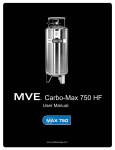
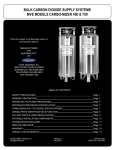
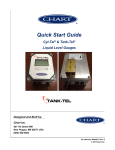
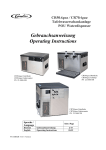

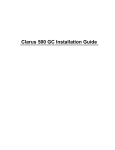
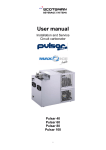


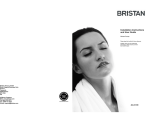

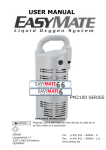
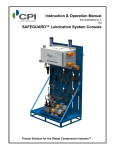
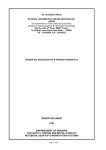
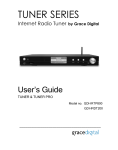
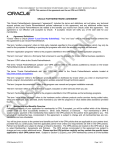
![FCB Modem Software User Manual [ 002706 ]](http://vs1.manualzilla.com/store/data/005828465_1-1c68a7b174dea68ac1a15f0d4e9b2df8-150x150.png)
